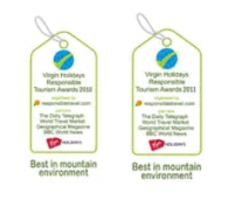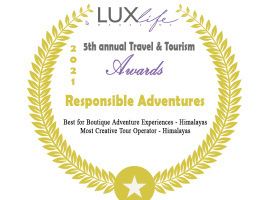It is widely established that the Nepal Himalaya’s peak times are October–November and March, and April. However, trekking during the less busy season has its advantages.
There are two recognized off-peak seasons for trekking in Nepal – the winter and the monsoon.
The benefits of going on a trek during the low season.
The trails won’t be busy with other trekkers, and you won’t have queues to shower at the lodge. Sometimes you could be the only trekker in the hostel. Trekking during the off-season is my favourite period.
Trekking during December, January, and February.
The colder winter months mean the clouds rise later to cover the beautiful mountains that Nepal is famous for. Winter is often the clearest time of year due to the colder temperatures. Sometimes the hills stay visible for days on end.
Won’t it be cold, and what about snowfall?
It can be crisp to cold in the mornings, depending on how high you are. However, you will warm up as soon as you start your day’s hike; you could even be sweating while walking. Have warm layers of clothing in your daypack to layer up when you stop for lunch or at the end of the day. In the evenings, the lodge owners light up the heater in the dining, which should keep you nice and toasty.
We receive precipitation a few days every month except during the monsoon, when it rains more frequently. You might get snowfall in the higher altitudes, usually above 3000 meters, but it melts away in a couple of days. You might think to be at the base of the world’s highest mountains; snow could cover the trails and make it risky to trek. Remember that Nepal’s latitude is similar to Cairo and Miami, which is not too far north of the equator, making it much less cold than Europe or North America. You would still have to be careful when you come across frozen streams and might encounter icy parts on the trail early in the mornings or where the sun doesn’t shine much.
Believe it or not, Nepal receives more snowfall during spring than winter. Therefore, an added benefit of winter trekking is that you will burn more calories as your body keeps you warm.
Trekking in Nepal during May and June
It can be pretty hot in the lower elevations of your trek, but it starts being more refreshing and pleasant as you gain altitude. If you are going to a height above 4500 meters, you will see many flowers in bloom, and it is green everywhere. You will also see beautifully colourful moths of all sizes during these months.
Another benefit of this trekking during May and June will be burning calories; as it is warmer, you will sweat more, which means detoxification.
Trekking will lack other trekkers and no queues to go through narrow trails or cross bridges during the end of the season’s most significant benefit. You will feel like you have the hills entirely to yourselves at times. You will walk through peaceful villages and their farmland, take your time to stop to observe the villagers go about their daily lives, and photograph them.
Don’t be surprised if you are the only one at some lodges. The lodge owners won’t be as busy as during the peak season; some like to mingle with you. You could learn about their lifestyle, ask them how tourism has helped them, etc. This could be the beginning of a new friendship. If you are travelling with a small group, you can have leisurely meals, chat, and discuss other trekkers without being self-conscious.

Weather Patterns
The weather is the most significant concern for those planning to trek during the off-season. The weather in the mountains is unpredictable – more so these days with the effects of global warming. You can be fortunate to see glimpses of the majestic peaks even during May and June. There have been some years when severe weather has affected Lukla or Jomsom’s flights for up to a week during the best times of October and November. I led two treks in July 2017 – one to Helambu and one to Annapurna Base Camp. The Helambu trek was great because we barely saw a total of 10 other trekkers for the entire seven days we were there. We often had lodges to ourselves. The lodge owners were grateful for the income we brought to them during the off-peak season. Unfortunately, we didn’t get to see any snow-clad Peaks. It rained on us for some part of the days – mainly during the afternoons.
It rained on us a few days during the monsoon trek to Annapurna Base camp. However, when we were at Machapuchare and Annapurna base camp, the clouds opened up, and we were rewarded with stunning views of the mountains. Unlike in Helambu, we were surprised by how busy the trek to Annapurna Base camp was. As mentioned before, the weather in the mountains is unpredictable. Hundreds of flowers also greeted us, and we enjoyed eating wild herbs and vegetables that only grow during the monsoon season.
The scenery was lush green on both these treks. While trekking during the summer months, you will see farmers working their land or crops growing on their farmland and wake up to the song of birds in the morning.
Can’t trek during the peak season?
Don’t despair if you can take time off to trek during the peak season. You can avoid the crowds and have the trail, hills, and lodges to yourself. Consider visiting Nepal to do a hike during the off-season months of December, January, May, and June or even during the monsoon months of July and August. Mother Nature is always beautiful; we must find positive aspects of what lies in front of us. As the saying goes – “If life gives you lemons – make lemonade.” Happy trekking!

Do I get a discount when I go trekking during the offseason?
The answer is no. You don’t get discounts when you go trekking during the offseason because:
- The lodge owners have to keep their employees to serve the trekkers.
- They are braving the discomfort of winter or running out of supplies if the monsoon rains wash off the road to trail to serve a few trekkers who come trekking during the off-peak season.
- The food suppliers do not give the lodge owners discounts for purchasing their goods during the low season.
- The mule owners or porters do not give the lodge owners discounts during the offseason.
- Sometimes the mules/porters can get stuck on the trail due to snowfall during the winter or landslides during the monsoon, which will take them longer to reach their destinations.
- If you have booked with a trekking company, their crew can get stuck on the way to the starting point due to heavy snowfall or landslide and take longer to reach the starting point.
- The delays also increase the expenses of those stuck on the way.
The best reason would be to avoid other trekkers for social distancing and have your private bubble.
Trekking regions that are in the Rainshadow areas:
You will be visiting one of the scenic trekking trails in the monsoon season in Nepal. Once an independent Kingdom that was later annexed into Nepal’s territory, Upper Mustang is one of the restricted trekking destinations in Nepal that requires a special permit and to be booked with a tour operator. Back Packers are not allowed to trek here. The Buddhists who once followed the Bon religion inhabit the Upper Mustang predominantly. Upper Mustang is a high-altitude desert. During the monsoon season, you will witness the rivers’ increased water levels, including the holy and mighty Kali Gandaki River.
This trekking destination takes you to one of the most remote regions in Nepal. The followers of the Bon religion, followed by Buddhists and Hindus, mainly inhabit it. The locals’ terrain, culture, and traditions are very close to the Tibetan way of life. The trekking trail partly lies in the Shey Phoksundo National Park, Nepal’s most extensive National Park. It is the only National Park in the trans-Himalaya region. The beauty of this region is unparalleled to other trekking destinations. Upper Dolpo doesn’t receive continuous rainfall in the rain shadow region. Trek here for the unique culture, landscape, scenery, and biodiversity.
Jomsom to Muktinath Trek – email us for the itinerary.
This trekking destination is more popular as a pilgrimage that is suitable during the monsoon season in Nepal. Muktinath attracts both Hindus and Buddhists alike for pilgrimage. Thus, you may embark on a spiritual or adventurous trek to this area, which remains dry most of the year, except in the winter when the region is covered by snow. Besides the holy Muktinath Temple, Kagbeni is the other popularly travelled destination in this region.
















